A plant disease is a disturbance brought about by a factor, which interferes with the manufacture, transport and utilization of energy sources or mineral nutrients and water in such a way that plant growth is negatively affected. Plant diseases are caused by pathogens and environmental factors. A plant pathogen is an organism that grows on a plant and provides growth factors. These organisms are generally not capable of producing their own food sources. The pathogenic organisms that cause disease are funguses, bacteria, mycoplasms, viruses and nematodes. Environmental factors which can cause plant diseases include temperature extremes, soil moisture extremes, light extremes, lack of oxygen, pollutants and nutrient stress. This section deals with the pathogenic origins of plant diseases.
Fungal Diseases
- Fungi cause fungal diseases.
- Fungi are plants that do not contain chlorophyll thus they are not green and cannot convert sunlight energy to chemical energy.
- Fungi cannot produce carbohydrates for their own usage.
- The vegetative parts of fungi consist of thin filaments known as hyphae, which masses together form a body or a mass known as a mycelium.
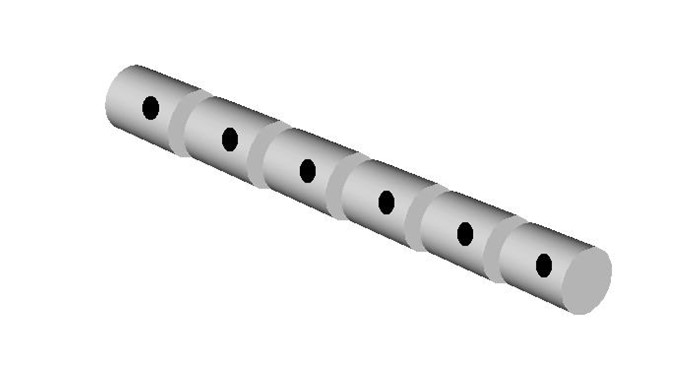

Diagrammatic representation of the fungal filaments, known as hyphae (left) and a hyphal mass known as mycelium (right).
- Fungi reproduce vegetatively through the filamentous hyphae and sexually through spores.
- Fungi as a group are divided into two sub-groups, the slime moulds (lower fungi) and the true fungi (higher fungi).
- Disease-causing fungi are found in both these groups.
Lower Fungi
The lower fungi – diseases are caused by three distinct groups of lower fungi. These diseases are discussed below:
- Diseases caused by lower fungi without hyphae - are soil-borne diseases that have a limited host range. The fungi rest and survive as resting spores in soil or in infected plants. They spread through the movement of infected plant material, soil and water. Diseases of this nature are clubfeet in crucifers, powdery scab and wart disease in potato and maize brown leaf spot
- Diseases caused by lower fungi with hyphae and zoospores – these fungi produce mycelium, form resting spores, produce living swimming spores (zoospores) which infect plants and spread through infected soil, infected plant material and airborne sporangia. Examples of these types of fungal diseases are downy mildew and late blight.
- Fungal diseases caused by lower fungi with hyphae but without zoospores - produce mycelium, produce air-borne thin-walled spores and are generally weak parasites that grow on dead plant material. These fungi will attack live plant tissue only if the plant is under stress. Examples of these diseases are pumpkin fruit rot, vegetable soft rot, bread mould and fruit rot.
The Higher Fungi
Sooty moulds - causes a flat black coloured film on leaf surfaces which can be rubbed off, leaving a clean surface. It is common in warm, humid areas and is found on all crops. The organisms are not parasitic but use sugary excretions from aphids as a food sources. The primary damage caused is lowered photosynthetic rates.
Leaf curl – causes leaf blistering and swelling that lead to leaf curl. Blisters are hollow and are found mainly on stone fruits. The disease leads to leaf drops which could weaken trees. The fungus survives in the buds of trees.
Powdery mildew – A common disease, white to grey in colour, covering either the entire leave or part of it and usually on both sides of the leaf. It is found on young tissues and only grows on the plant surface. They are parasites and infestations are most severe under warm, dry weather conditions.
Foliar diseases – generally leaf spots and blights but may also affect other plant parts. May survive in soil or on plant debris.
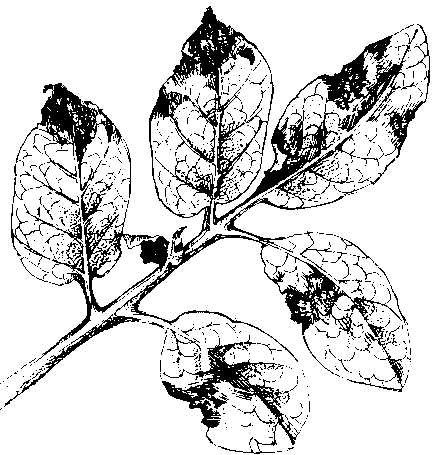
Illustration of potato leaf infected with late blight.
This disease also causes lesions on stems, and brown patches on the skins of tubers rendering tubers unmarketable.
Alternaria – a disease in annual crops causing leaf spots and blights may also cause damping-off, collar-, fruit- and tuber rot. Common on older plant tissues under nutrient stress. Numerous dark leaf spots usually occur on affected plants. Survive on debris and seed.
Cercospora – small, separate leaf spots, circular to triangular in shape. Found on broadleaf and grass species. Under humid conditions grey mould lesions are visible. Spores are airborne with the disease is most severe under warmer conditions.
Septoria – small leaf spots that may join to form blights. Leaves become chlorotic. The infection starts on the lower, older parts and gradually progresses upwards.
Helminthosporium – a major disease in grass crops, causing leaf spots and blight as well as crown and root rot.
Stem and twig canker – start where the branch or twig is injured, or at the joint of a dead branch or twig. Cankers can kill branches and twigs; the infection is counteracted by callus formation.
Anthracnose – dark spots or sunken lesions on the leaves, stems, shoots and fruit. Survive on plant debris.
Ergot – common on grass species, produce honeydew in infected florets, which is replaced by hard purple-black fungal masses called sclerotia. These are toxic to animals and humans.
Botrytis – common in glasshouse grown crops, causing blossom blight and fruit rot. Grey to brown mould surviving on debris.
Vascular wilt – fungi grow in the vascular systems of the plant, blocking the water transportation, leading to wilting of plant tissues. Fusarium and Verticulum are soil-borne fungi, which are difficult to control.
Post-harvest decay of fruit and vegetable products occurs after harvest. Wounding of produce and high temperatures and humidity increases decay.
Post-harvest decay of stored grain – is often initiated in the field and causes decay and discolouration of grains decreasing marketability. Some species produce mycotoxins.
Rust – attack many hosts but causes the highest losses in staple crops damaging mainly leaves and stems. Rust to yellow coloured pustules forms with gall formation. Rusts are parasitic and generally not systemic.
Smut – mostly affect the ovaries of grain crops, but also attack leaves and stems. It May become systemic that can cause stunting. Survive on debris and seed.
Rhizoctonia – root and stem disease, which is soil-borne and difficult to control. Survives in soil or in plant material. Symptoms include damping-off, wire-stem, cankers, root lesions, rot and potato black scurf.
Sclerotonium – common in wet areas, causes damping-off, stem canker, crown blight and rot, fruit rot and wilt.
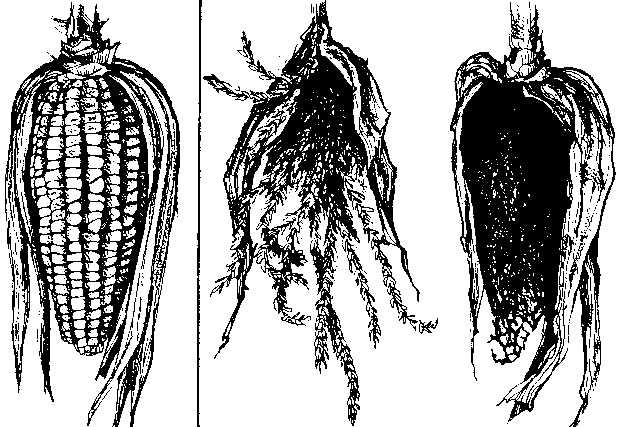
Cob and tassel smut in maize plants (right). The cob on the left is healthy.
Bacterial Disease
Click here to view a video that explains bacterial vs fungal diseases.
Bacteria are small, simple unicellular living organisms. There are four main shapes of bacteria namely spherical, rod-shaped, helix and comma-shaped. All plant disease-forming bacteria are rod-shaped, with the exception of Streptomyces, which are filamentous. The reproduction of bacteria is simple, through cell division. Some bacteria are mobile through flagella, but mobility is limited to short distances. Bacteria multiply quickly if food sources are available and may reach a million within hours. They occur in almost all plants.
Disease forming bacteria may survive in soil, without the presence of the host plant, whilst others disappear as infected plants are removed. The main dispersion mechanism for bacteria is rain and water, but they can also be spread through the transport of infected plant material, insects or animals.
Bacterial diseases are classified according to the symptoms they produce.
Spots, steaks and blights – these bacteria cause stripes and spots on the leaves, stems and fruit of crop plants. The bacterial blights and the leaf spots can flow into each other. Symptoms are necrotic spots, circular spots with a halo around them. When limited by leaf veins, the spots maybe angular. On grass crops, the symptoms are streaks and stripes rather than spots. Shot hole effects are visible when the infected tissues fall out.
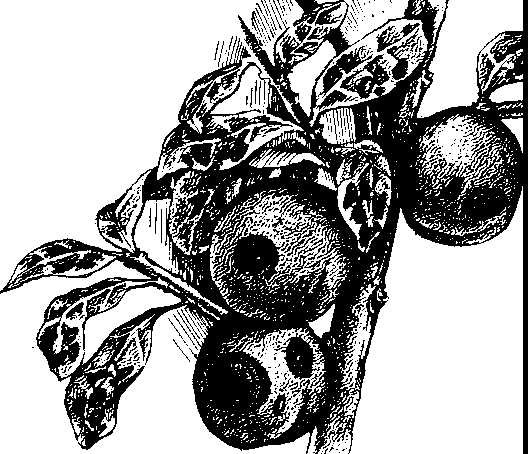
Bacterial Black Spot on plum fruit and leaves.
Vascular wilt – is found mainly on herbaceous crops where the bacteria multiply in the vascular tissue, eventually blocking the transport system. The end results are wilting of the plant and eventual die-back. Discolouration of vascular tissues is not uncommon.
Soft rot – enters plant tissues mainly through wounds and could spread through storage. Leads to the separation of plant tissue cells and tissue collapse.
Galls – crown gall in woody species is caused by a bacterium.
Cankers – causes splits and cankers in woody tissues. Spot formation on leaves and fruit and die-back of buds and blossoms.
Scab – the bacterium enters the plant tissue, causing the plant cells around the point of entry to divide, forming layers of corky cells, pushing the infected tissue out and forming of scabs.
Plant Viruses
Viruses are smaller than a cell and can only multiply within a cell. A large number of viruses are known, and a plant can be infected by more than one at the same time.
The major symptoms of virus infections are; reduced growth, colour mosaics, ring-spots, stem pitting, chlorosis and leaf roll.
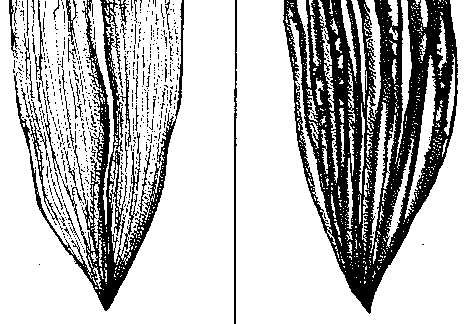
Chlorosis is caused by the maize streak virus. (Streaks on maize leaves)
Viruses are classed into one of five major groups according to their morphology.
Rigid rod-shaped viruses – are rod-shaped in the range of 300 nm by 15 nm with the RNA in the centre. The tobacco Mosaic Virus is an example of this type of virus.
Flexible rod-shaped viruses –they are longer and thinner than rods. An example is the beetroot yellow disease virus.
Icosahedric shaped viruses – the surface consists of 20 identical flat planes, with the RNA is in the centre. (e.g. Cucumber mosaic virus)
Bacillus-shaped viruses – these are bullet-shaped viruses, such as the Lucerne mosaic virus.
Viruses with double string RNA – some viruses such as the rice dwarf virus have a double string of RNA.
Large membrane viruses – these are almost spherical structures and are surrounded by a membrane.
- Viruses are not transmitted through rain or wind.
- Virus transmission requires a vector.
- Viruses can be transmitted through the movement of plant sap from infected to uninfected plants, such as in grafting.
- Viruses are transmitted through infected seed stocks, pollen, fungi and especially insects.
The most virulent plant diseases are transmitted through insect vectors.